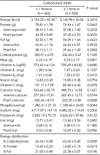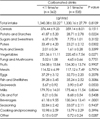Abstract
Purpose
This study was conducted to evaluate nutrition intake and diet quality according to carbonated drink consumption in male adolescents (middle-school students = 480, high-school students = 417).
Methods
We analyzed data from the combined 2007~2009 KNHANES (Korean National Health and Nutrition Examination Survey). Subjects were divided into two groups, the LCDI (low carbonated drink intake (< 1 time/week), n = 362) group and the HCDI (high carbonated drink intake (≥ 1 time/week), n = 535) group, according to carbonated beverage consumption. Nutrient and food group intake, NAR (nutrient adequacy ratio), and MAR (mean adequacy ratio) were analyzed using data from the 24-recall method.
Results
Intake of plant protein, vitamin C, plant calcium, phosphorous, and potassium was significantly lower in the HCDI group, compared with the LCDI group. Percent of RNI (recommended nutrient intake) of vitamin C and phosphorous was significantly lower in the HCDI group, compared with the LCDI group. Percentage of subjects who consumed under EAR (estimated average requirement) of protein and vitamin C was significantly higher in the HCDI group, compared with the LCDI group. The NAR of phosphorous was significantly lower in the HCDI group, compared with the LCDI group. Food intakes from potato and starches, pulses and vegetables were significantly lower in the HCDI group, compared with the LCDI group.
Figures and Tables
References
1. Kim MH, Bae YJ, Kim YH, Choi MK. The study of dietary habits and satisfaction with school lunch program for high school boys and girls in Chungnam province. Korean J Food Nutr. 2009; 22(4):598–605.
2. Story M, Neumark-Sztainer D, French S. Individual and environmental influences on adolescent eating behaviors. J Am Diet Assoc. 2002; 102:3 Suppl. S40–S51.

3. Ministry of Food and Drug Safety (KR). The report of sugar intake 2010-2012. Cheongju: Ministry of Food and Drug Safety;2014.
4. World Health Organization (CH). Diet, nutrition, and the prevention of chronic diseases. Report of a joint WHO/FAO expert consultation. WHO Technical Report Series, No. 916. Geneva: World Health Organization;2003.
5. Ministry of Health and Welfare, Korea Centers for Disease Control and Prevention. Korea Health Statistics 2009: Korea National Health and Nutrition Examination Survey (KNHANES IV-3). Cheongwon: Korea Centers for Disease Control and Prevention;2010.
6. Yoon SS, Kim HJ, Oh KW. Dietary habits of Korean adolescents: results of Korea youth risk behavior web-based survey. Public Health Wkly Rep. 2014; 8(34):795–799.
7. Chung SJ, Kim JH, Lee JS, Lee DH, Kim SH, Yu CH. A suggestion to develop a nutrition policy on food and nutrition labeling and education systems for fast food and carbonated soft drinks in Korea. Korean J Nutr. 2004; 37(5):394–405.
8. Park JY, Ryu K, Jang HL, Yoon KY. Carbonated beverage consumption among middle school students in Daegu area. J East Asian Soc Diet Life. 2010; 20(2):201–208.
9. Ock SM, Kim CM, Ock CM, Choi WS. Bone acquisition related health behavior factors and nutritional uptake in high school girl student. J Korean Acad Fam Med. 2002; 23(7):905–916.
10. Song MJ, An EM, Shon HS, Kim SB, Cha YS. A study on the status of beverage consumption of the middle school students in Jeonju. Korean J Community Nutr. 2005; 10(2):174–182.
11. Kang BS, Park MS, Cho YS, Lee JW. Beverage consumption and related factors among adolescents in the Chungnam urban area. Korean J Community Nutr. 2006; 11(4):469–478.
12. Gibson RS. Principles of nutritional assessment. New York (NY): Oxford University Press;1990.
13. Chung H, Eum YH, Kim JY. A study on the children's eating habits and food preference according to their parents' economic status (I): Seoul & Gyeonggi (Incheon) area. Korean J Nutr. 2008; 41(1):77–88.
14. Bae YJ. Evaluation of nutrient intake and meal variety with breakfast eating in Korean adolescents: analysis of data from the 2008~2009 National Health and Nutrition Survey. Korean J Community Nutr. 2013; 18(3):257–268.

15. Wesnes KA, Pincock C, Richardson D, Helm G, Hails S. Breakfast reduces declines in attention and memory over the morning in schoolchildren. Appetite. 2003; 41(3):329–331.

16. Bae YJ, Yeon JY. Evaluation of nutrient intake and diet quality according to beverage consumption status of elementary school, middle school, and high school students: from the Korean National Health and Nutrition Examination Surveys, 2007-2008. Korean J Nutr. 2013; 46(1):34–49.

17. Kim SY, Ryu SA. The relationship between beverage consumption, nutrient intake and body mass index in elementary school students in Gyeongnam area. Korean J Nutr. 2008; 41(6):530–538.
18. Kann L, Kinchen S, Shanklin SL, Flint KH, Kawkins J, Harris WA, Lowry R, Olsen EO, McManus T, Chyen D, Whittle L, Taylor E, Demissie Z, Brener N, Thornton J, Moore J, Zaza S. Centers for Disease Control and Prevention (CDC). Youth risk behavior surveillance--United States, 2013. MMWR Surveill Summ. 2014; 63:Suppl 4. 1–168.
19. Cho HS, Kim YO. The study on Korean youth's status of beverage consumption and preference of beverage in Chunnam area. Korean J Food Nutr. 1999; 12(5):536–542.
20. Her ES, Lee KH, Bae EY. Interrelations among beverage intake, food behavior and personality in adolescents. Korean J Community Nutr. 2008; 13(2):189–198.
21. Park EH, Bae YJ, Kim SK, Kim MH, Choi MK. A study on beverage consumption of elementary school students in Chungnam. Korean J Food Nutr. 2011; 24(3):376–385.

22. Bae YJ. Evaluation of nutrient and food intake status, and dietary quality in Korean adults according to nutrition label utilization: based on 2010-2011 Korean National Health and Nutrition Examination Survey. J Nutr Health. 2014; 47(3):193–205.

23. The Korean Nutrition Society. Dietary reference intakes for Koreans, 1st revision. Seoul: The Korean Nutrition Society;2010.
24. Kleiser C, Schaffrath Rosario A, Mensink GB, Prinz-Langenohl R, Kurth BM. Potential determinants of obesity among children and adolescents in Germany: results from the cross-sectional KiGGS Study. BMC Public Health. 2009; 9:46.

25. Malik VS, Schulze MB, Hu FB. Intake of sugar-sweetened beverages and weight gain: a systematic review. Am J Clin Nutr. 2006; 84(2):274–288.

26. Bowman SA. Beverage choices of young females: changes and impact on nutrient intakes. J Am Diet Assoc. 2002; 102(9):1234–1239.
27. Mrdjenovic G, Levitsky DA. Nutritional and energetic consequences of sweetened drink consumption in 6- to 13-year-old children. J Pediatr. 2003; 142(6):604–610.





 PDF
PDF ePub
ePub Citation
Citation Print
Print









 XML Download
XML Download